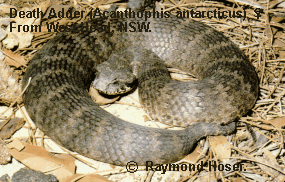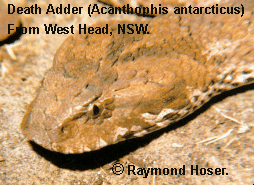 DEATH ADDER Acanthophis antarcticus (Shaw and Nodder, 1802)
DEATH ADDER Acanthophis antarcticus (Shaw and Nodder, 1802)
This dangerous viper like snake is found in most parts of NSW, the southern half of Queensland, and southern parts of Western Australia and South Australia. It may occur in parts of the Northern Territory. Specimens from the Barkly Tableland area of the NT and Qld are now known as A. hawkei, while those from the Djarra area of Qld, were renamed A. woolfi in 1998.
The base colour of the Death Adder is usually 'red' or 'grey', however within these parameters, colour may range from yellows, reds, browns, greys, black, or even green. Average adult length is 57 cm however specimens up to a metre long are known. Females generally attain a much larger size than males.
The scalation is slightly keeled with 21 mid body rows, 110-130 ventrals, single anal, and 40-55 subcaudals of which about half are divided.
The Death Adder has the most effective biting mechanism of any Australian snake, and has highly neurotoxic venom. Before the development of anti-venom about 60% of all recorded Death Adder bites were fatal. Death Adders generally are not aggressive, however they will strike with great accuracy at anything coming within range, including airborne objects. It will when agitated, flatten its' entire body.
 This snake is particularly dangerous because of its' habit of lying concealed in leaf litter on the ground, and not moving away when approached by humans. It then bites when trodden on.
This snake is particularly dangerous because of its' habit of lying concealed in leaf litter on the ground, and not moving away when approached by humans. It then bites when trodden on.
Although this snake will occur in a variety of habitats, it is restricted to virgin (unaltered) bushland, where it is most common in low scrub habitats with plenty of leaf litter.
This species is mainly nocturnal, and is most active on warm nights with falling air pressure. Most specimens caught are mature males, looking for mates.
The food of this snake consists of all suitable vertebrates including birds, which it catches by wriggling it's tail as a lure. The 'food' animal will come towards the tail thinking that it is some kind of worm or insect and be bitten whilst doing so.
Mating occurs at any time of year, although mainly in autumn and spring.
Gestation appears to be from 7 to 9 months for this snake, with from 3 to 40, (Average 20), live young being born in late summer or early autumn.
Most females only reproduce every second year, but some do so annually. This pattern of reproductive frequency is genetically determined and is not dependant on the food availability for females. The young which are more brightly coloured replicas of their parents, may be of red
or grey base colour, even if from the same parent, (again genetically determined with red being the dominant allele/type of gene). They average 16-17cm at birth, and take 2 or 3 years to become adults.
In captivity, Death Adders have been bred more often than any other venomous Australian snake.
Death Adder Taxonomy.

The above was from the book Australian Reptiles and Frogs by Raymond Hoser and now available on a fantastic CD-Rom along with a vast amount of other information, papers and the like on reptiles, frogs and other wildlife.